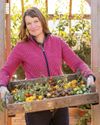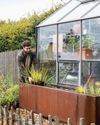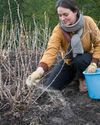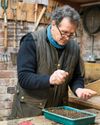
The very fact that the choice is so wide makes deciding what to plant in your garden a real challenge. I mean, where do you start? What goes in first? How will you know what will do well and what will simply sulk? As with most problem areas in life, approaching things methodically is the best way forward.
The ideal garden (if such a thing there be) is one which has something of interest all the year round (granted, in June and July this is easier to achieve than in November), one which has form and stature as well as colour, and one in which the plants are growing happily thanks in part to your soil and situation, but also to your ability to offer them a bit of TLC.
The plants you choose will affect the whole mood of the garden and although this can vary depending on the part of the country where you live - how warm, how cold, how sheltered or how windy it is, coupled with the prevailing soil conditions - the approach to planting is the same the world over: start with the big stuff and work your way downwards.
Start with structure
Construct your garden's planting scheme as if you were creating a human body. Yes, I know your name is not Dr Frankenstein, but this approach offers a good way of remembering that the bones that form the skeleton come first (trees and large shrubs), followed by the flesh (smaller plants and evergreens to offer year-round form) and the features (the colourful, seasonal plants) which are usually smaller, come last. Build your framework - on paper in plan form if it helps - and work out what will look good where. Take your plan outside and see if you can visualise it in reality.
Esta historia es de la edición April 2023 de Gardeners World.
Comience su prueba gratuita de Magzter GOLD de 7 días para acceder a miles de historias premium seleccionadas y a más de 9,000 revistas y periódicos.
Ya eres suscriptor ? Conectar
Esta historia es de la edición April 2023 de Gardeners World.
Comience su prueba gratuita de Magzter GOLD de 7 días para acceder a miles de historias premium seleccionadas y a más de 9,000 revistas y periódicos.
Ya eres suscriptor? Conectar

Sweet pickings
What are the best cordon cherry tomatoes to grow? Lucy Chamberlain tested a dozen varieties to find the sweetest, juiciest and heaviest cropping options for the season ahead

ON TEST Mini chainsaws
Take the strain out of pruning trees and shrubs with a handy, battery-powered, mini chainsaw. Harry Duncton puts six products to the test to see if they make the cut

DIY garden projects
To end his series, Henry Agg explains how to make a rainwater pond filled with aquatic plants

Act now for wildlife
Gardeners across the UK have been stepping up to support wildlife and combat related issues such as climate change. GW Wildlife Editor Kate Bradbury reveals the results of this year's review, celebrating successes and exploring how we can all help

Make the most of your kitchen garden
Getting out into the garden in winter, even for short spells, keeps things ticking over, especially fruit and veg crops, as Adam Frost explains

YOUR PRUNING MONTH
February is a great time to prune many garden plants, from herbaceous perennials to holly topiary, says Frances Tophill

Garden globetrotting Seville
With the cross-cultural architecture of its buildings and the gardens' diverse planting, the Real Alcázar de Sevilla has so much to offer visitors that Matt Collins has to resort to his diary to recall its every detail

Potting on a winter show
Nick Bailey saves the best till last, ending his winter container series with a vibrant display packed with plants in rich plums and silver

Growing THE GOOD LIFE
Join urban smallholder Sara Ward as she begins the month with a few key jobs for the year ahead

Sowing for Success
Start your growing year on the right footing with Monty's timely guide to sowing a garden full of colour and flavour